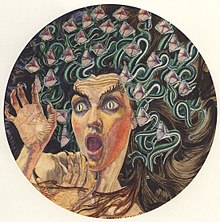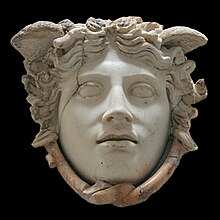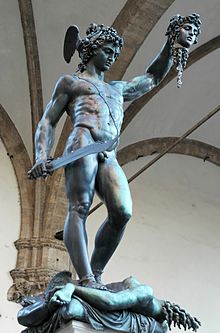Medusa
Medusa ( ancient Greek Μέδουσα ) is in Greek mythology, a Gorgon , the daughter of the sea gods Phorkys and keto , and the sister of Stheno and Euryale . She was the only one of the three Gorgons to have a mortal nature.
myth
The three sisters Medusa, Stheno and Euryale, also called Gorgons, were children of the chthonic gods Phorkys and his sister Keto and were originally seen in Greek art as deformed from birth. The figure was developed in the late classical period. After that, Medusa was originally a bewitching beauty. But when Pallas Athene surprised Poseidon while making love with Medusa in one of her temples (according to Ovid he took her by force), she was so angry that she turned Medusa into a monster with snake hair, long pig tusks, scale armor, bronze arms, glowing eyes and tongue hanging out. The sight made everyone turn to stone.
The hero Perseus , son of the god father Zeus and the princess Danaë , was confronted with these Gorgons : Polydectes , who, to Perseus' displeasure, was chasing after Danaë, asked Perseus to bring him the head of Medusa in the hope that Perseus would do this - like everyone who had tried so far - do not survive. That would have paved the way to Danaë for Polydectes.
But Perseus had Athena on his side, who lent him a mirrored shield. From Hermes he received winged shoes, nymphs gave him a cloak of invisibility . In his wing shoes he hurried across the sky to the end of the world. Athena hoped to be able to completely eliminate the wicked Medusa through Perseus and explained to him how he could behead Medusa without looking into her face and therefore having to freeze to stone. When the Gorgons fell asleep, Perseus stalked Medusa with the help of the cloak of invisibility. He did not look directly at her face, but only at its image, which was reflected in Athene's shield. With one targeted blow he beheaded Medusa and ran away, while behind him the screams and angry nagging of her terrified sisters could be heard.
When Perseus beheaded Medusa, the first winged horse named Pegasus arose from her body , since Medusa was impregnated by Poseidon after he had assumed the form of a horse. The warrior Chrysaor , who is sometimes depicted as a horse like Pegasus, also arose from the torso of Medusa.
The head of Medusa in the pouch, Perseus flew with Pegasus over the sea to Ethiopia, where he saved the king's daughter Andromeda from Keto . Her fiancé Phineus (son of Belos) did not want to leave Andromeda in the hero's hands in spite of the brave deed, whereupon Perseus used the head of Medusa in a duel and so Phineus turned to stone. In other cases, too, the severed head of Medusa turned out to be a cheap weapon: When the Titan Atlas , who carried the heavens on his shoulders, did not act in the interests of Perseus, the latter presented him with the head of Medusa, whereupon Atlas solidified into a mountain range - the Atlas Mountains in Morocco. When ill-disposed warriors rushed at him at his wedding, whose leader wanted to marry Andromeda, who had been freed from Perseus and promised him years ago, Perseus only had to show them the head of the Gorgon and they froze like Atlas to stone.
Pallas Athene then attached the head of Medusa to her shield as special protection; later it became known as the Gorgoneion . Pallas Athene gave the blood of Medusa to Asklepios and Erichthonios .
Head of Medusa
( Peter Paul Rubens and Frans Snyders )Gorgon Medusa 130 AD
( Roman-Germanic Museum )Spolie with Medusa head
( Cisterna Basilica [Yerebatan sarnıcı] Istanbul)Perseus with the head of Medusa
( Antonio Canova , 1804–1806)
Representations



Early pictorial representations of the Gorgons can be found, among other things, in Greek black-figure vase painting . Their distorted faces are characterized by the large mouth area with numerous, often pointed teeth and a protruding tongue. They have wings and snakes also occur early as body parts, which, however, may not necessarily start on the head, but also on the shoulders, for example. In contrast to the other depicted human and mythological figures in the archaic vase painting, their faces are not shown in profile, but from a frontal view.
reception
The “ Medusa Rondanini ” by the Greek sculptor Phidias shaped the classically beautiful Medusa type. Created around 450 BC BC for the shield of a statue of Athens in the Parthenon , the 38 centimeter marble sculpture is now in the Munich Glyptothek , after the Bavarian Crown Prince Ludwig acquired it from the Rondanini collection in Rome in 1815 for his own collection. In this sculpture, two snakes are tied together under the chin, their heads protruding from the otherwise natural hair. The work is considered a high point of ancient sculpture, as it depicts Medusa according to the Hellenistic ideal and without fear.
Particularly well-known later artistic processing began with the Renaissance and the artist Benvenuto Cellini , whose Perseus sculpture shows him conquering Medusa. Other famous depictions of the “Head of Medusa” are by Caravaggio and Peter Paul Rubens , the latter with snakes by the famous animal painter Frans Snyders .
Sculptures by Camille Claudel (1864–1943) and Auguste Rodin (1840–1917) also depict Perseus and Medusa. Claudel's Perseus lies at the feet of the decapitated, winged Medusa; Perseus holds his head in his left hand and lets it look into a mirror in his right hand. The Perseus Rodins stretches the head of Medusa far from him and seems to want to float to rise, while the decapitated Medusa is still clutching the joint of his right foot with one hand. Both sculptures can be interpreted as symbols of the love affair between Claudel and Rodin.
Franz von Stuck shows the fight between Perseus and Phineus in an impressive and surprisingly expressionistic way .
Günter Seuren uses the motif in his contemporary novel The Raft of Medusa ; Vercors published a novel with the same title in 1969. In his novel Medusa from 1986, Stefan Schütz deals with the Greek saga about Medusa in surreal images. In 1986 the novel was awarded the Alfred Döblin Prize .
The figure has also found its way into popular culture; A Medusa head forms the logo of the Italian fashion company Versace . Gorgons can be found in computer games such as Heroes of Might and Magic 3 , Dota 2 , Castlevania and God of War as well as Age of Mythology , Titan Quest , Assassin's Creed Odyssey and NetHack (in whose world Perseus was petrified but left his shield behind ).
In the 1981 movie Clash of the Titans , Medusa is one of the characters animated by the trick specialist Ray Harryhausen . Medusa also plays a role in the remake from 2010 .
Klaus Heinrich , the Berlin religious philosopher , developed a story of fascination based on the Medusa myth . Heinrich raises the question of whether a change from matriarchy to patriarchy takes place in the myth of the Gorgon .
In the autobiographical novel " Das Mädchen auf dem Eisfeld ", published in 2018, Adélaïde Bon describes the physical suffering as a result of the rape she suffered as a young girl as tentacles or medusas that suddenly and initially without any recognizable connection take possession of her body. In the process of remembrance and healing, she directs her gaze, following Ovid's portrayal, to the violence suffered by the figure: "Then I am Medusa, the little daughter of the earth and the sea, secretly raped by Poseidon inside a temple, I am her desecrated and found guilty innocence, (...) the one whose head is cut off while she sleeps, whose mutilated remains terrified entire armies, I am what remains of a woman after a rape. "
literature
- Adolf Furtwängler : Gorgones . In: Wilhelm Heinrich Roscher (Hrsg.): Detailed lexicon of Greek and Roman mythology . Volume 1,2, Leipzig 1890, Col. 1695-1727 ( digitized version ).
- Volker Mergenthaler: Gorgon. In: Maria Moog-Grünewald (Ed.): Mythenrezeption. The ancient mythology in literature, music and art from the beginnings to the present (= Der Neue Pauly . Supplements. Volume 5). Metzler, Stuttgart / Weimar 2008, ISBN 978-3-476-02032-1 , pp. 297-302.
Web links
- Aaron J. Atsma: Medusa and the Gorgons. Serpent-Haired Monsters. In: Theoi Project (English)
Individual evidence
- ↑ Aaron J. Atsma: Medusa and the Gorgons. Serpent-Haired Monsters. In: Theoi Project .
- ↑ Klaus Heinrich. Raft of the Medusa , Barbara Nasterlack.
- ↑ Adélaïde Bon: The girl on the ice field . 1st edition. Carl Hanser Verlag GmbH & Co. KG, Berlin 2019, ISBN 978-3-446-26203-4 , pp. 159-160 .








